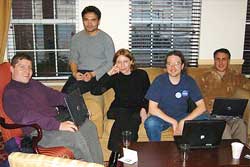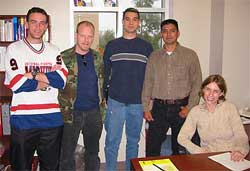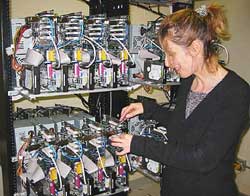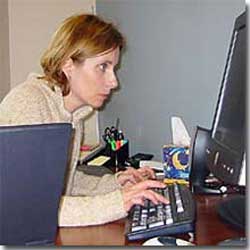Manuela Campanelli
Physics can take you places – sometimes all the way across the world. That's what it did for Manuela Campanelli, a physicist born in Switzerland and educated in Italy who has worked in Germany and the United States and married a fellow physicist from Argentina. Today, she teaches at the University of Texas at Brownsville, 100 yards from the U.S-Mexico border. Campanelli says that her international travels have left her with a unique perspective on the world. “Travel has given me some of everything, and I'm trying to get the best of everything,” she says.

Pictured here are (from L to R) Peter Diener (AEI, Germany), Ryoji Takahashi (TAC, Denmark), Manuela Campanelli (UTB), John Baker (NASA Goddard), and Carlos Lousto (UTB). This is an international team of young physicists who collaborate together on the Lazarus Project.

UTB graduate and undergraduate students (from L to R: Santiago Pena, Sean Morriss, Ariel Martinez, and Jose Zamora) working with Dr. Campanelli on Grid Computing (GriPhyN and iVDGL).

Dr. Campanelli, working on the Beowulf Linux cluster, a supercomputer used to study gravitational radiation signals from colliding black holes. The supercomputer works on Lazarus simulations and grid computing applications, in addition to analyzing data from the LIGO observatories.

Dr. Campanelli reviewing her work. Related story links:Lazarus Project, GriPhyN, iVDGL, Education and Outreach, University of Texas at Brownsville
When Campanelli was twelve years old and living in Switzerland, she saw Carl Sagan's famous TV series, Cosmos, which gave a grand tour of the universe as astronomers then understood it. Sagan's picture of the universe amazed her. "Nothing is more beautiful than a star or galaxy,” she says today. “If I could travel out there and find the answers, I would.” She decided to study astrophysics to try to find out more about the universe.
When she was 14, Campanelli's family moved to Italy, where she was one of only two women to study science in secondary school. Her parents didn't want to send her to a school far away from home, so she went to the University of Perugia in central Italy, which did not have an astrophysics major. She studied applied math but kept enough interest in astrophysics that she was invited to attend a conference about black holes. While there, she was encouraged to apply for a graduate degree in theoretical physics at the University of Bern in Switzerland.
At Bern, the town where in 1907 Albert Einstein had the “happiest thought of his life,” Campanelli studied his Theory of General Relativity. She met her future husband, a physicist from Argentina named Carlos Lousto, at a black hole conference in Italy. They moved together to the University of Utah and then to the famous Max Planck Institute in Germany, where they began to use computer simulations to understand how black holes come together, or “coalesce.”
In Germany, Manuela and Carlos worked together on a new research project called the “Lazarus Project,” which uses computer simulations to understand the so-called “black hole coalescence process.” The process is expected to produce gravitational waves—tiny variations in gravity —that might be detectable from Earth in the near future. The Lazarus Project models what these waves might look like. This will help other physicists better understand what they might soon detect.
However, black hole coalescence presents a big challenge to computer simulations. Black holes have such powerful gravity that only Einstein’s General Theory of Relativity can predict what should happen – but General Relativity's equations are so complicated that they cannot be solved exactly, and powerful computers are required to find approximate solutions. Before the Lazarus Project came along, predicting gravitational waves from colliding black holes was beyond even the most powerful supercomputers.
The idea behind the Lazarus Project is simple. Since the computer has so much trouble with black hole calculations, physicists should only use the computer for the part of the calculations where it is most needed. Before black holes coalesce, when they are far apart, they attract each other like any two objects. After coalescence, they are essentially one big black hole. In both cases, the situation is fairly easy to understand. It's only in the middle, during the coalescence process itself, that the computer is really necessary.
By using the supercomputer to simulate only the middle part of the collision, simulations that had never worked before suddenly gave interesting predictions. It seemed as if these simulations had been raised from the dead, as in the Biblical story of Lazarus. And that was how the Lazarus Project got its name.
The Lazarus Project has brought Campanelli and her colleagues attention from the physics community; it was profiled in Nature, a prestigious science magazine. After the Nature profile, Campanelli received several job offers. She chose to go to the University of Texas at Brownsville, a city at the extreme southern tip of Texas.
Brownsville is a small city, with a population of 140,000 that is primarily Mexican-American. The University is also small, having only become part of the University of Texas system in 1991. Campanelli joined several other young astrophysicists there to start a new research center with an independent and fresh perspective. “We wanted to start a group of young people with the freedom and possibility to grow,” she says. Recently, NASA recognized Campanelli's research by creating a new “University Research Center for Gravitational Wave Astronomy” at the university.
In Brownsville, Campanelli has continued her research and has also begun to work with students and teachers to improve local science education. She is leading the education and public outreach component of two new projects: the “Grid Physics Network” (GriPhyN) and the “International Virtual Data Grid Laboratory” (iVDGL). GriPhyN and iVDGL have created a network of supercomputers around the world; Campanelli plans to help Brownsville students tap into the network to do real scientific research. “There weren't a lot of opportunities to do science here [in Brownsville],” she says, “but I'm amazed by the students when they're given the opportunity.” Campanelli does her research and education work from her office at the university, situated about 100 yards from the U.S.-Mexico border. She often goes into Mexico for dinner.
Being a globe-traveling physicist has helped Campanelli see the excitement of the entire world. She speaks Italian, French, Spanish, English, and some German. "It was really exciting to learn all these cultures and languages," she says. "I feel part of this world, not just one nationality."











